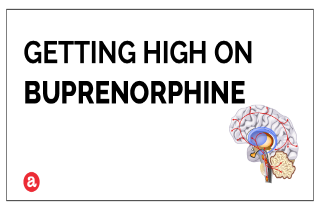It’s pretty difficult to get high on buprenrophine. In fact, buprenorphine has been designed to block symptoms of opiate withdrawal and cravings by activating the opiate receptors in the central nervous system. But buprenorphine, in general, is not an intense enough drug to produce the heightened feelings of euphoria created by other opioids or opiates. More on buprenorphine abuse potential here, with a section for your questions about buprenorphine addiction treatments at the end.
What is buprenorphine?
Buprenorphine, the main active ingredient in brand name drugs such as Buprenex®; Butrans™; Subutex®, and Suboxone, is a medicine used for treating opiate or opioid addiction. Buprenorphine works a lot like methadone, but instead of getting it at a special clinic, a doctor prescribes it to you in an office and you can take it at home. This process can make treatment and administration easier for you. But how does buprenorphine work in the brain?
Buprenorphine and central nervous system effects
Buprenorphine works by stimulating and occupying the brain’s opiate receptors but only partially satisfies them by not being a perfect fit. Thus, buprenorphine helps to ease withdrawal symptoms and drug cravings by activating the opiate receptors but not in an intense enough way to produce the heightened feelings of euphoria that heroin would produce. If a user attempts to take another opiate such as heroin while taking buprenorphine, there will be no effect.
Buprenorphine and euphoria or euphoric effect
Buprenorphine blocks symptoms of withdrawal and craving and helps you to not use heroin, morphine, or stronger opioid medications. Buprenorphine stops these opiate based drugs from getting you “high” and interrupts withdrawal symptoms and cravings (the strong feeling that you need to have it). Buprenorphine does not get you high if you use it the right way and it does not cause strong side effects. Plus, it is hard to get sick or overdose from it.
Getting high on buprenorphine
Opioid naive people are most likely to experience any kind of buprenorphine “high”. However, buprenorphine is rarely prescribed for those who have not already developed some kind of tolerance to opiate/opioid based medications or illicit opiate drugs.
Risks of buprenorphine abuse
Risks of buprenorphine abuse are relatively low because the medication has been designed to have a “ceiling effect” based on dosage. So doses of 18-32 mg can be effective, but higher doses are unlikely to produce greater effect. In other words, buprenorphine has been designed to make it difficult to get high. There are three steps, or “phases” of buprenorphine treatment for opiate addiction:
1. Induction phase
This period usually lasts for about one week. The goal is to figure out the dose of burprenorphine that works best to relieve user’s withdrawal symptoms and craving. The first dose is usually administerd during the early stage of withdrawal – about 10 to 24 hours after their last dose of stronger opiates/opioids. First users take a test dose, followed by another dose to relieve withdrawal symptoms. Then, a doctor may ask users to stay in the office for several hours after their first dose to see how the early doses affect them. During the first week, they may have to see doctor several times. The dose can be raised if withdrawal symptoms are still present.
2. Stabilization phase
The goal in this phase of buprenorphine prescription is to continue to avoid withdrawal symptoms or cravings. Usually this phase lasts for about 1-2 months. Patients get a prescription for and take buprenorphine at home. Doctor may increase the dose so that they do not have to take buprenorphine every day.
3. Maintenance phase
While maintaining doses of buprenorphine, users visit the doctor’s office to get a refill of buprenorphine about once a month. If patients have a medical history of long time heroin/opiate/opioid use and/or relapse, they may do best taking buprenorphine for a very long time. The key is to not go back to using stronger drugs and to adapt lifestyle changes before coming off buprenorphine for good.
Questions about buprenorphine
Do you still have questions about buprenorphine use or abuse? Please leave your questions in the comments section below. We’ll do our best to respond to you personally and promptly.









Related Posts